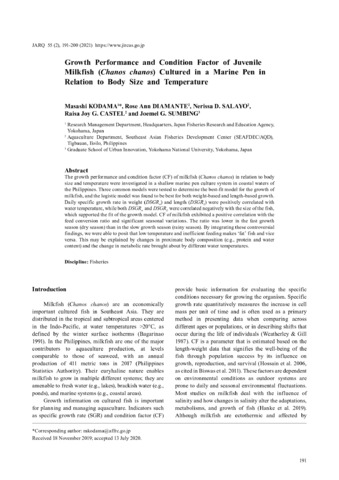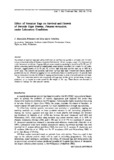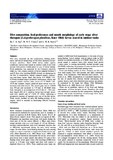| dc.contributor.author | Watanabe, Satoshi | |
| dc.contributor.author | Zarate, Jacques M. | |
| dc.contributor.author | Sumbing, Joemel Gentelizo | |
| dc.contributor.author | Lebata-Ramos, Maria Junemie Hazel | |
| dc.contributor.author | Nievales, Marie Frances | |
| dc.date.accessioned | 2014-09-08T03:36:16Z | |
| dc.date.available | 2014-09-08T03:36:16Z | |
| dc.date.issued | 2012 | |
| dc.identifier.citation | Watanabe, S., Zarate, J. M., Sumbing, J. G., Lebata-Ramos, M. J. H., & Nievales, M. F. (2012). Size measurement and nutritional condition evaluation methods in sandfish (Holothuria scabra Jaeger). Aquaculture Research, 43(6), 940-948. | en |
| dc.identifier.issn | 1355-557X | |
| dc.identifier.uri | http://hdl.handle.net/10862/2130 | |
| dc.description | We are grateful to Jesus Rodriguez, Rema Sibonga, Harold Figurado and Roy Hipolito at SEAFDEC/AQD for the assistance in sandfish culture. This study was funded by the Japan International Research Center for Agricultural Sciences (JIRCAS). | en |
| dc.description.abstract | The aims of this study were to establish an accurate size measurement method and a nutritional condition evaluation method of Holothuria scabra (Jaeger). Although 0.5% KCl and 0.05% MgSO4 did not induce anaesthesia, 2% menthol–ethanol for 20 min was found to be effective and harmless. The anaesthetization significantly reduced the coefficient of variation of the mean body length and weight by 68% and 43% respectively. During starvation, body size and weight decreased concomitantly, resulting in an unchanged condition factor (body weight/volume), suggesting that the condition factor cannot be used as an index of nutritional condition. Protein, cholesterol and carbohydrate concentrations in the body fluid were analysed to study the relationship with starvation. As the protein and cholesterol concentrations initially increased and then decreased during the starvation period, it is difficult to use them as an index of nutritional condition. The carbohydrate concentration showed a gradual one-fold increase during 10 days of starvation, and it may be used as a proxy for nutritional condition; however, further physiological studies are needed. Body fluid density and volume relative to body size gradually increased and decreased, respectively, during starvation. These methods may be used to correctly monitor the conditions of H. scabra in studies for aquaculture and stock enhancement techniques. | en |
| dc.language.iso | en | en |
| dc.publisher | Wiley | en |
| dc.subject | scabs | en |
| dc.subject | potassium chloride | en |
| dc.subject | Holothuria scabra | en |
| dc.subject | menthol | en |
| dc.subject | Nutritional condition | en |
| dc.title | Size measurement and nutritional condition evaluation methods in sandfish (Holothuria scabra Jaeger) | en |
| dc.type | Article | en |
| dc.citation.volume | 43 | |
| dc.citation.issue | 6 | |
| dc.citation.spage | 940 | |
| dc.citation.epage | 948 | |
| dc.citation.journalTitle | Aquaculture Research | en |
| dc.subject.asfa | anaesthesia | en |
| dc.subject.asfa | aquaculture | en |
| dc.subject.asfa | body fluids | en |
| dc.subject.asfa | body length | en |
| dc.subject.asfa | body size | en |
| dc.subject.asfa | body weight | en |
| dc.subject.asfa | carbohydrates | en |
| dc.subject.asfa | cholesterol | en |
| dc.subject.asfa | condition factor | en |
| dc.subject.asfa | length-weight relationships | en |
| dc.subject.asfa | nutrition | en |
| dc.subject.asfa | size | en |
| dc.subject.asfa | starvation | en |
| dc.identifier.essn | 1365-2109 | |
| dc.identifier.doi | 10.1111/j.1365-2109.2011.02908.x | |



